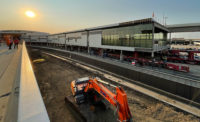Construction Begins on Nation's First Direct-to-Distribution Water Reuse Facility

The water purification facility will be built under a construction manager at-risk contract.
Rendering courtesy of Carollo Engineers
Construction has begun on a 10-million-gallon-per day advanced purification facility in El Paso, Texas—the first direct potable reuse project of its kind in the U.S. The purified water will supplement local supplies during dry seasons and reduce amounts that are withdrawn from the Rio Grande.
El Paso Water (EPWater) worked with the Texas Commission on Environmental Quality (TCEQ) for more than a decade to ensure that the drinking water produced at this facility will meet all state and federal requirements. In late 2024, TCEQ granted final design approval, allowing construction to move forward. Designed by Carollo Engineers, the Pure Water Center will be built by a PCL/Sundt Joint Venture under a $295-million CM-At-Risk contract.
EPWater has been operating a pilot facility since 2016. The advanced purification process includes membrane filtration, reverse osmosis, ultraviolet light with advanced oxidation, granular activated carbon filtration and chlorine disinfection.
The pilot plant was required by state regulations, says Gilbert Trejo, vice president of EPWater. “It was a learning process to understand all the vendors and technologies out there.” The agency consulted with peers in Southern California and visited equipment manufacturers. “There were thousands of samples and results, and hundreds of visitors to the plant.”
The new facility is part of EP Water’s $1.2-billion overall program that includes a $595-million retrofit of the existing Roberto Bustamante Wastewater Treatment Plant and a $230-million upgrade of the Haskell facility, all also being done by the joint venture, says Ankur Talwar, district manager for PCL's Civil Infrastructure Division. The Bustamante plant will provide the water that goes to the new plant.
“The technology been in place for decades, and now the application is coming to the forefront,” says Talwar. “There are now groups and organizations solely focused on purification.”
Crews are working in a greenfield area adjacent to the Bustamente plant, beginning with soil reinforcement. “There will be a number of large concrete structures, below-ground piping connecting facilities, and piping within the footprint to connect the processes,” says Talwar. “Each of these technologies require large equipment.” Some 10,000 cubic yards of concrete will be placed and about 40,000 of linear ft of piping will be installed at the 13-acre site.
The facility will also serve as a de facto education/technology center, adds Nicholas Iannello, Sundt project executive. “It has to look nice.”
The U.S. Bureau of Reclamation awarded $3.5 million in 2019 for the facility’s design and committed an additional $20 million in 2022 to support construction. The total project cost is currently estimated at $295 million, and EPWater continues to pursue additional state and federal funding. Construction is expected to be completed in 2028.
The technical aspects of designing the plant were not as challenging as the regulatory coordination, notes Caroline Russell, Carollo vice president and chief technologist. “There are drinking water regulations in place for conventional groundwater sources.” But for some of the new processes, “we had to do exception requests.” The team had to develop the technical information that TCEQ needed to grant the permits.
Trejo adds: “We joined forces to push regulators out of their comfort zone. The regulators didn’t want to give us as much credit as we felt our treatment was doing. Carollo did the calculations and proof to convince them we do deserve our treatment train.”
“When we started the preliminary engineering, we saw an opportunity to take fresh look at the core treatment train,” Russell says. “The water reuse field is advancing quickly. We looked at UV advance oxidation with hydrogen peroxide or chlorine and ways to set up the membrane filtration process so that down the line, there is flexibility to bring in new membranes as the market advances.”




